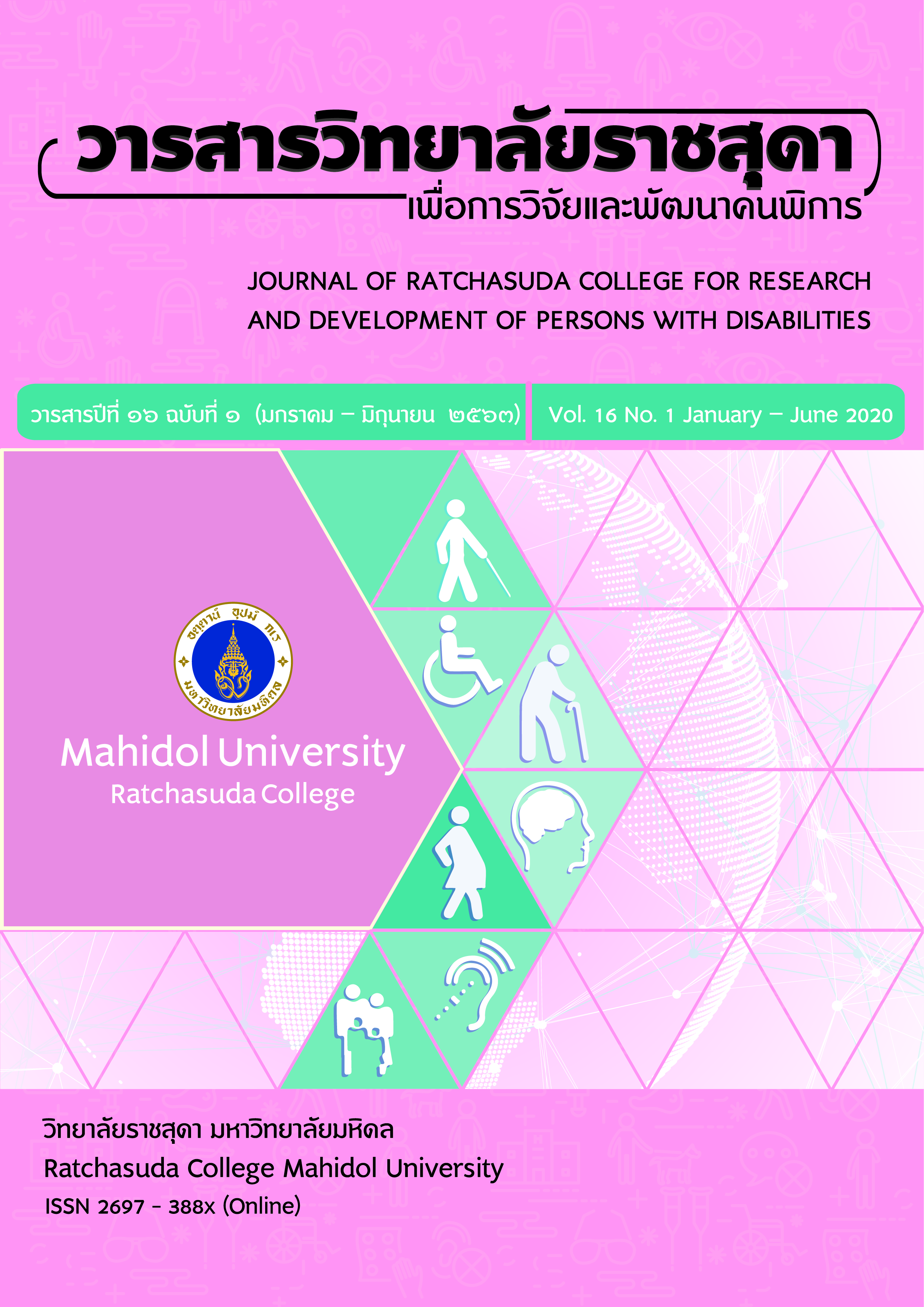The Communication of People with Physical Disability’s Identity via News Websites in Thailand
Abstract
This qualitative research aimed 1) to study the presentation of the identity of people with physical disability through the news headlines and news picture in a news website of an organization that is a member of the Federation of Thai Broadcasting and Television Professions, 2) to study the presentation of the identity of people with physical disability through the news headlines and news picture in a news website of the organization founded by people with physical disability, and 3) to study the relationship between the identity of people with physical disability on both websites. The results reveal the identity of people with physical disability from the news website of an organization that is a member of the Federation of Thai Broadcasting and Television Professions are persons with physical differences, they are not the same group to general people, they are miserable and pitiful, but they have the ability. The identity of people with physical disability from the news website of the organization founded by people with physical disability are persons with physical differences, they are not the same group to general people, they are not miserable and pitiful, and they have ability. The relationship between the identities in the two websites agreed on people with disability identity are persons with physical differences, they are not the same group to general people, and they have the ability. The disagreed identity is persons with disability are miserable and pitiful. This reflects that Thai society is during the transition period of changing the perspective towards disabilities but had not yet loosened negative attitudes toward people with disability. However, it has been changing bit by bit due to online landscape that allowed them to negotiate and refuse discourse in the news and are able to dignify representations of their own as members of society.
Downloads
References
Braille-Cet. (2018). Convention on the rights of persons with disabilities 2018. Data in Thailand: 19 April 2018. [In Thai]. Retrieved from http://www.braille-cet.in.th/Braille-new/?q=news-1286
Clogston, J. S. (1989). A theoretical framework for studying media portrayal of persons with disabilities. The Annual Meeting of the Association for the Education in Journalism and Mass Communication (Research report). Washington,D.C.:
Clogston, J. S. (1990). Disability coverage in 16 newspapers. Louisville, KY: Advocado Press.
Clogston, J. S. (1991). Reporters' attitudes toward and newspaper coverage of persons with disabilities. (Unpublished doctoral’s dissertation). Michigan State University, East Lansing.MI:
De Fina, A., Schiffrin, D., & Bamberg, M. (2006). Discourse and identity. Cambridge: Cambridge University Press.
Department of Empowerment of Persons with Disabilities. (2019). Report of Disability Situation. Data in Thailand: 19 April 2019 [In Thai]. Retrieved from http://dep.go.th/Content/View/4232/1.
Department of Empowerment of Persons with Disabilities. (2019). Type and Criteria of Disability. Data in Thailand: 6 May 2019 [In Thai]. Retrieved from http://www.ratchakitcha.soc.go.th/DATA/PDF/2552/E/077/2.PDF.
Fairclough, N. (1990). Language and power. London: Longman.
Fairclough, N. (1995). Critical discourse analysis: The critical study of language. London: Longman.
Fairclough, N., & Wodak, R. (1997). Critical discourse analysis. In T. Van Dijk (ed.). Discourse Studies: A Multidisciplinary Introduction, 2, 258-284.
Gitlin, T. (1980). The whole world is watching. Berkeley, CA: University of California Press.
Haller, B. (1995). Disability rights on the public agenda: News media coverage of the Americans with Disabilities Act. (Unpublished doctoral’s dissertation). Temple University, Philadelphia.PA:
Haller, B. (1995). Rethinking models of media representation of disability. Disability Studies Quarterly, 15(2), 26-30.
Haller, B. (2010). Representing disability in an ableist world: Essays on mass media. Louisville, KY: Advocado Press.
Haller, B., Panaitescu, M.D., Rioux, M., Laing, A., Vostermans, J., & Hearn, P. (2012). The place of news media analysis within Canadian disability studies. Canadian Journal of Disability Studies, 1(2), 43-46.
Haller, B. & Zhang, L. (2014). Stigma or empowerment? What do disabled people say about their representation in news and entertainment media?. Review of Disability Studies, 9(4), 19-33.
Jittima, J. (2008). The construction of disable self identities. (Doctoral dissertation). Retrieved from http://thesis.swu.ac.th/swudis/Dev_Ed/Jittima_J.pdf
Kanchana, K., & Nikhom, C. (2012). New media handbook. Bangkok: Pabpim Press.
Mackelprang, R. W. & Salsgiver R. O. (2016). Disability: A diversity model approach in human service practice. New York, NY: Oxford University Press.
Malee, B. (1994). Basic newspaper principles. Bangkok: Prakaipruk.
Natthanan, K. (2015). Critical discourse analysis of the relationship between language and identity of people with disabilities in Thai society from the perspective of people with and without disabilities, 1991-2011. (Doctoral dissertation). Retrieved from https://dric.nrct.go.th/index.php?/Search/SearchDetail/287970
Natthanan, K., Wilaisak, K., & Wipawan, Y. (2015). Positive identity with negative implications of the disabled: The relationship between language and identity of the disabled in Thai society. Silpakorn University Journal, 35(1), 125-148.
Pennapa, K. (2010). Gender ideology in headlines of criminal news in Thai newspapers: A critical discourse analysis. (Doctoral dissertation). Retrieved from http://cuir.car.chula.ac.th/handle/123456789/36307
Phillips, M.J. (1990). Damaged goods: The oral narratives of the experience of disability in American culture. Social Science & Medicine, 30, 849-857.
Ratana, P. (2002). Reality construction and the judgment of news subjects through story narration in newspapers. (Master’s thesis). Retrieved from http://cuir.car.chula.ac.th/handle/123456789/946
Ryffel, A. F., Wirz, D. S., Kühne, R., & Wirth, W. (2014). How emotional media reports influence attitude formation and change: The interplay of attitude base, attitude certainty, and persuasion, Media Psychology, 17(4), 397-419.
Sasithon, Y. (2002). Audience’s definition of news. (Master’s thesis). Retrieved from http://cuir.car.chula.ac.th/handle/123456789/981
Shoemaker, P.J. Stephen D. & Reese, S.D. (1996). Mediating the message, theories of influences on mass media content. New York, NY: Longman.
Suneerat, L. (2004). Discourse in suicide in Thai newspapers. (Master’s thesis). Retrieved from http://cuir.car.chula.ac.th/handle/123456789/1059
Thanomnual, H. (2008). Disability discourses in modern Thai narratives. (Doctoral dissertation). Retrieved from http://cuir.car.chula.ac.th/handle/123456789/57066
Tavee, C. (2008). Prospective on disability through concept and theory. Bangkok: Thana Press.
Thepporn, M. (2006). A Study of meaning and value of life of people with disabilities in buddhism: A case study of buddhist monks' understanding in Khonkaen province (Research report). Nakhon Pathom: Ratchasuda College, Mahidol University.
Downloads
Published
How to Cite
Issue
Section
License
บทความที่ได้รับการตีพิมพ์เป็นลิขสิทธิ์ของวารสารสถาบันราชสุดาเพื่อการวิจัยและพัฒนาคนพิการ






